Helicopter rescue on Race to Mackinac
Published on August 18th, 2021
After the Chicago Yacht Club’s Race to Mackinac was cancelled in 2020 due to the pandemic, the 112th edition in 2021 attracted 231 boats for the 289.4 nautical mile course from Chicago to Mackinac Island.
While benign weather made for a largely uneventful event, a dramatic incident for one team required urgent action which resulted in a positive outcome. Craig Warner, racing on a J/105 in his 35th Mac, was within 10 miles of the incident and followed up with those involved to share this report:
After their start on July 17, a serious medical emergency occurred on the water miles from land, with the successful outcome due to a combination of the crew’s action and the professional response of the United States Coast Guard.
On Monday, July 19, at approximately 1135 HRS CDT off North Fox Island in the northern half of Lake Michigan, a crewmember on a Farr 40 collapsed on the deck without warning and experienced a seizure. The crewmember was the son of the owner.
If you have ever seen a person suffering through a seizure, it is not a pleasant sight. Being a dad myself, I can only begin to imagine the level of the father’s concern. A severe medical emergency condition existed and calling 911 for an ambulance was not an option. The crew needed help, and they needed it now!
The Farr 40s crew initially ran to the aid of their suffering friend. The crewmember underwent two seizures back to back. The person in charge made a radio call on VHF CH 16 to the Coast Guard. After an initial delay, the Farr 40 established communications with the Coast Guard.
The Farr 40 informed the Coast Guard of their status, and the Coast Guard responded with questions to clarify the situation. Then came a decisive question from the Coast Guard, “Do you request medical evacuation?” The Farr 40 answered in the affirmative, and their reply put in motion a series of events.
Behind the scenes, Coast Guard personnel on the watch floor of Sector Sault Ste Marie’s Command Center studied the problem and assessed which rescue assets were available. The command center quickly determined that launching both a helicopter and a response boat would create the optimum chance of survival.
At Coast Guard Air Station Traverse City, an MH-60 Jayhawk helicopter crew prepared to launch a routine training mission. When the request for aerial assets was received, the crew of 4 -two pilots, a flight mechanic, and a rescue swimmer – immediately transitioned from training mode to response mode. As soon as the aircraft commander had determined the Jayhawk was mission-ready, it launched, heading for their target at some 140 knots.
At the same time, one of the Coast Guard’s 45-foot Response Boat-Medium, or RB-M, was at its slip in Charlevoix, Michigan. The station crew was standing its regular day watch when the SAR (Search and Rescue) alarm sounded. The duty crew responded to their boat, determined a plan of action, and set out to rendezvous with the Farr 40 and the Jayhawk.
Onboard the Farr 40, the person in charge had a satellite telephone and called his personal physician. The doctor stayed on the line until the Coast Guard arrived some 20 minutes later. The doctor advised the crew on how to handle a person having a seizure. His recommendation was a great comfort, but the crewmember suffering from seizures still desperately needed hospital attention.
Within 30 minutes of making their initial distress call, the crew of the Farr 40 heard the distant sound of the rotors of the Jayhawk. While enroute, the crew of the Jayhawk conducted a detailed discussion as to their course of action, evaluating the weather, water conditions, and the seriousness of the emergency.
Realizing that the Farr 40’s mast, towering nearly 60-feet over the deck, would prevent the rescue swimmer’s deployment and recovery directly to and from the vessel, the Jayhawk crew determined that the safest and quickest option would be to drop the rescue swimmer into the water near the Farr 40.
Once in the water, he would swim to the boat, board her, take over the medical care of the seizure victim, and prepare him for extraction. With the victim stabilized, the RB-M would be able to come alongside the Farr 40 and transfer the Jayhawk’s rescue basket from the aircraft to the Farr 40.
After being secured in the basket, the victim could then be handed back to the Coast Guard small boat and hoisted into the Jayhawk. The swimmer would then board the RB-M to be hoisted aboard the Jayhawk. While all this was taking place, the Jayhawk maintained a hovering position over the two boats.
This sort of aerial ballet does not just happen. It is the result of years of training both on the Jayhawk and the RB-M. While hovering, the Jayhawk pilot cannot see his target but is guided by the commands from the flight mechanic, who will give the pilot flight corrections of less than a foot. The pilot must then maneuver the helicopter to just the proper position to carefully hoist the victim to the safety of the helicopter’s cabin.
Boat handling is just as delicate as it is easier for the helicopter to lift the victim from a moving boat. This maneuver is a testament to standardized training, teamwork, crew resource management, and leadership. To the layman, this operation is a feat of superhuman achievement (and it is). To the Coast Guard, it is something they do and practice all the time.
The Jayhawk and the RB-M arrived nearly simultaneously. The plan came off without a hitch. The rescue swimmer boarded the Farr 40 and took over the victim’s medical care. From there, the rescue swimmer organized the transfer from the Farr 40 onto the RB-M and the final evacuation into the Jayhawk.
In an emergency like this, every minute is critical, and the Coast Guard wasted no time, with the professionalism of the Coast Guard rescue team on full display. After the Jayhawk had recovered both its newest passenger and the rescue swimmer, it pointed itself towards its destination and departed instantly for a hospital in Traverse City, Michigan. The rotor sound diminished, and before long, it was entirely out of sight.
The Jayhawk’s crew was nothing less than Guardian Angels embracing their charge and bringing him to safety. They quickly reached the hospital’s designated landing area and handed off the victim, now a patient, to the medical staff at the Traverse City hospital. The RB-M took the dad onboard. As soon as the Jayhawk departed, the RB-M headed to Traverse City and the son’s hospital.
The helmsman told the father that they would be traveling a little faster than usual as the coxswain pushed the RB-M to 40 plus knots as they headed to Traverse City. A Coast Guard vehicle met the boat upon its arrival and drove the dad to the hospital. The dad reported that the Coast Guard never left his side until they were at the hospital. I am sure that the father silently prayed for his son’s recovery and the Coast Guard did everything they could to help relieve his anxiety.
This incident is an excellent example of the rescue capability we racers and boaters have at our disposal when we need it. From the initiation of the first radio call to when the Jayhawk touched down at the hospital was just under an hour! The patient is recovering after a week in the hospital for observation. He is now home. The Farr 40 came back to its homeport two weeks later.
A lot of things went right in this emergency. The crew kept their cool, and the Coast Guard performed a successful helicopter evacuation. I have a personal involvement because I have known both the father and his son for over 20 years. After hearing firsthand of the Coast Guard’s performance, I can only sit back with a feeling of pride and awe.
As a former military officer and pilot, I know the dedication and training needed to pull off a mission of this complexity. WE ARE FORTUNATE TO HAVE THE BEST COAST GUARD IN THE WORLD working for us! If you have any doubts, ask the crew of the Farr 40, they will tell you the story.
To the United States Coast Guard’s Jayhawk crew, the RB-M boat crew, and the personnel at the command center, I sincerely want to thank you for getting my friend’s son swiftly to crucial medial Thank you for your service. Great Job – Semper Paratus!
There are a few safety takeaways from this episode that I would like to mention.
Communication: When faced with severe health or life-threatening situations, do not hesitate to make a MAYDAY CALL using standard phraseology. The word MAYDAY makes your radio call the highest priority. Correct use of words and a timely transmission will result in the fastest resolution of the problem.
PFDs: Always wear your offshore PFD while on deck racing. Even in daylight and in calm conditions, tragedy can strike. If the victim had fallen overboard into Lake Michigan’s 56° F water, suffering from a seizure without a self-righting PFD, he would have died. Develop a professional safety discipline. Always wear your PFD! There are no valid reasons for not wearing a PFD.
Every safety incident has lessons learned that will benefit us all. This incident is no exception. Never stop learning and implement those lessons learned into the safety culture of your boat. This story has a happy ending! Enough cannot be said to complement the actions of the United States Coast Guard. Let me offer a sincere thank you from all of us who race the Mac. BRAVO ZULU (well done)!


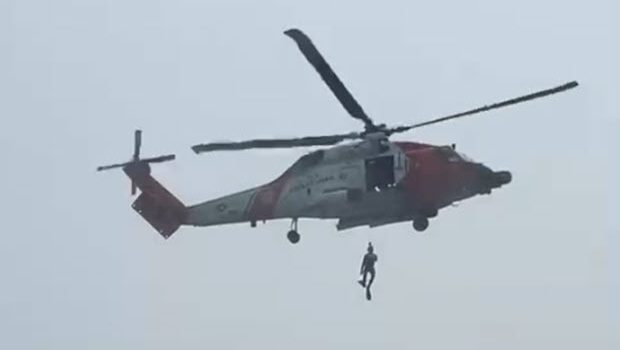


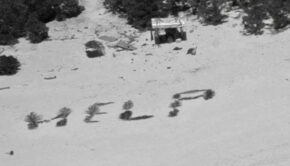
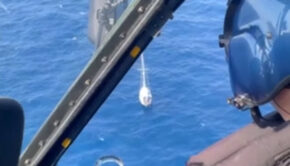
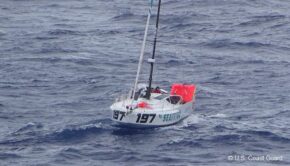
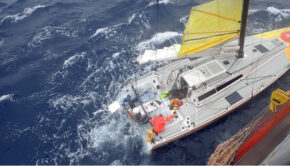
 We’ll keep your information safe.
We’ll keep your information safe.